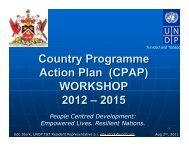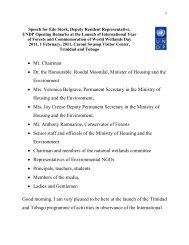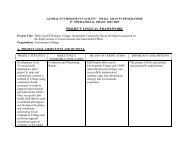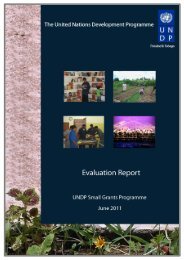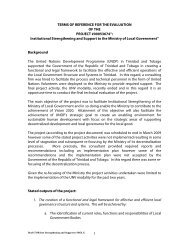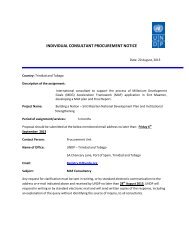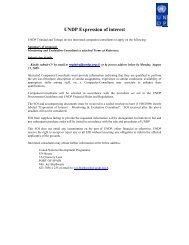The View from the Boardroom - UNDP Trinidad and Tobago
The View from the Boardroom - UNDP Trinidad and Tobago
The View from the Boardroom - UNDP Trinidad and Tobago
Create successful ePaper yourself
Turn your PDF publications into a flip-book with our unique Google optimized e-Paper software.
<strong>The</strong> <strong>View</strong> <strong>from</strong> <strong>the</strong> <strong>Boardroom</strong> - CEO Study on Corporate Social Responsibility in <strong>Trinidad</strong> <strong>and</strong> <strong>Tobago</strong>CHAPTER 3<strong>The</strong> Third Sector Revisited – Private Sector <strong>and</strong> Nonprofit Partnerships“My wife <strong>and</strong> I started an organisation a while agowhich is located in Laventille <strong>and</strong> is called K.I.N.D.(Kids in Need of Direction). <strong>The</strong>re we deal with kidswho have social problems, emotional problems,learning problems <strong>and</strong> once you have successfullyaddressed those issues you are surprised how far<strong>the</strong>y can go. Some of <strong>the</strong>m just graduated <strong>from</strong>university. It started off with almost no hope,<strong>the</strong>y were outside <strong>the</strong> system <strong>and</strong> it just showsif <strong>the</strong>y have <strong>the</strong> right input <strong>and</strong> care. Where <strong>the</strong>organisation is today is way beyond <strong>the</strong> point wherewe started it, we have a staff of around twelvepeople. In terms of <strong>the</strong> funding, we are running<strong>the</strong> NGO now for fifteen years in Laventille whichis a hot-spot community <strong>and</strong> we have not receivedone cent ever <strong>from</strong> any government ministry <strong>and</strong>we have virtually given up to secure financialassistance <strong>from</strong> <strong>the</strong> government. We receive a lotof funding <strong>from</strong> foreign donors. We spend a lot oftime marketing <strong>and</strong> fundraising <strong>and</strong> writing letters<strong>and</strong> we sometimes feel that we are a marketingorganisation when we are a service organisation.”Daniel Scott, CEOAnthony P.Scott Ltd.However, partnerships are not a winwinarrangement by default. In order toachieve targeted outcomes <strong>and</strong> developsustainable partnership structures,both companies <strong>and</strong> nonprofitorganisations need to pay considerableattention to <strong>the</strong> process of partnerselection <strong>and</strong> its strategic context,<strong>the</strong> design of joint projects <strong>and</strong> <strong>the</strong>management of mutual expectations.Selecting <strong>the</strong> right partner NGO -something that “can be <strong>the</strong> resultof ei<strong>the</strong>r a planned or an emergentprocess” 30 - is a crucial pre-requisitefor successful collaboration betweenbusinesses <strong>and</strong> nonprofits. Finding <strong>the</strong>right match for joint activities basedon a partnership approach requiresalignment of strategic direction, aclear underst<strong>and</strong>ing of <strong>the</strong> sharedresponsibility on assignments, arecognition that organizationalsize matters on both sides of <strong>the</strong>partnership <strong>and</strong> a thorough graspof <strong>the</strong> mutual needs <strong>and</strong> pay-offexpectations. <strong>The</strong> longevity, regularity<strong>and</strong> nature of partnership-drivenjoint initiatives may vary <strong>from</strong> caseto case <strong>and</strong> a company’s nonprofit‘portfolio’ may be characterised bysome degree of diversity. Eugen Tiah,CEO of Phoenix Park Gas ProcessorsLtd. points out that “we do partnerwith traditional NGOs. Sometimes<strong>the</strong> partnership is an ongoing type ofrelationship <strong>and</strong> sometimes it’s of aproject nature in that we work over anumber of years on a particular project<strong>and</strong> see that through to completion.But our model is that we will partnerwith an NGO <strong>and</strong> we will define whatwe expect in terms of governance <strong>and</strong>st<strong>and</strong>ards of performance. We definewhat <strong>the</strong> deliverables are, we definehow <strong>the</strong>y will be delivered <strong>and</strong> we alsodefine what we will st<strong>and</strong> for <strong>and</strong> whatwe won’t st<strong>and</strong> for.”In o<strong>the</strong>r cases, focusing on one’s owncore business guides companies in<strong>the</strong>ir selection process of nonprofitpartners. Ingrid Lashley, CEO of<strong>Trinidad</strong> <strong>and</strong> <strong>Tobago</strong> MortgageFinance Ltd. (TTMF) explains:“Habitat for Humanity is an NGO thatwe worked with very closely <strong>and</strong> onethat is in line with our business. Wetry to get people into a home, that iswhat we do as a business. Mortgagefinancing is <strong>the</strong> way we do it butour focus is always to put people inhomes. If we <strong>the</strong>refore have displacedboys we must find a home. If we havehomeless people we must find a home.If we have a home that is dilapidatedwe must contribute to building a30 Maria May Seitanidi, Andrew Crane, ‘Implementing CSR through partnerships: underst<strong>and</strong>ing <strong>the</strong> selection, design <strong>and</strong> institutionalisation of nonprofit-business partnerships’, Journal of BusinessEthics, Vol.5, No.2, Supplement 2, 2009, p.422.50





